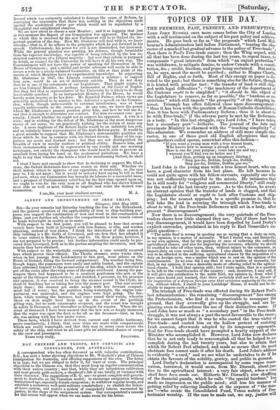SAFETY AND IMPROVEMENT OF IRON SHIPS.
Glasgow, 19th May 1852. Sis—In your remarks last Saturday touching the loss of the Birkenhead, and the general question of the applicability of iron to ship-building pur- poses, you suggest the combination of iron and wood in the construction of ships, and you further ask whether the compartments in iron vessels cannot be made watertight in reality as in name.
With respect to the first point, you will be pleased to hear that several -vessels have been built at Liverpool with iron frames, or ribs, and wooden planking, instead of iron plates. I think the introducer of this system of ship building is a Mr. Getty of Liverpool, and one firm that has adopted it to some extent is Messrs. MacIntyre and Co. On these points, however, I em not prepared to be precise; but further information could easily be pro- cured from Liverpool, both as to the parties adopting the invention, and the results they have obtained.
With respect to the watertight compartments, a case recently occurred here which proves their efficacy. The Thistle steamer, some weeks since, when on her passage from Londonderry to this port, went ashore on the North of Ireland, filling the forward compartment. The weather being fine, though foggy, the passengers were easily and safely landed, and the captain then addressed himself to the preservation of his ship, which he contrived to get off the reeks after throwing some of the cargo overboard. Among the pas- sengers there had happened to be a nautical gentleman who acts as the agent of the Glasgow underwriters ; and fortified, I presume, by his presence and opinion, it was resolved to bring the steamer round to the Clyde, in- stead of beaching her or taking her into the nearest port. This was accord- ingly done ; the steamer got under weigh with her forward compart- ment full of water ; but the partition being watertight, the engine com- partment was uninvaded, and the engines were kept going. The fire- men, while tending the furnaces, had ropes round their waists, whereby those on deck might haul them up in the event of the partition giving way, but no such catastrophe occurred, and the vessel was brought in safety to Greenock, and thereafter to Glasgow for repairs. When she ar- rived at Greenock I have been assured that the bow was so deeply immersed that the water was upon the deck as far aft as the foremast—that, in fact, she was sailing with her bow under water. These facts, which I have derived from current and credible testimony, prove conclusively, I think, that some ships are made with compartments which are really watertight, and that they may in many cases secure the safety of the ship, and must in all cases give an additional chance of escape to the crew and passengers.


























 Previous page
Previous page